Perennial Philosophy Class 1
Mike Ervin
Perennial Philosophy Class 1
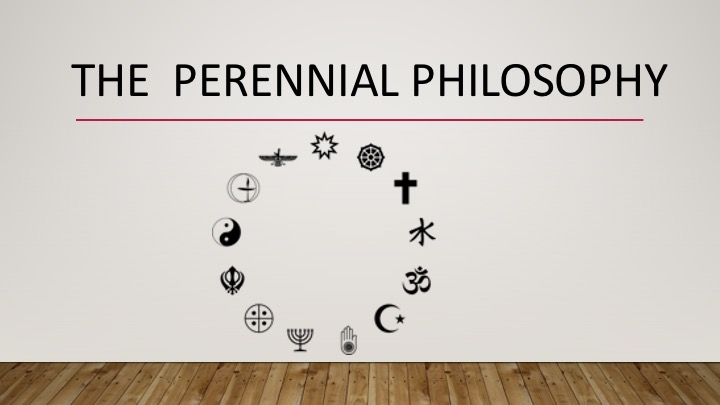
The Perennial Philosophy
And now for something completely different.
Some of you might be wondering how this subject ended up on our calendar for this year. In fact most of you might be thinking that.
Well – I have a simple answer to that – you voted for it. You may have forgotten that this subject has been suggested for the last three years as a possibility in our Open Forum meeting but never got any votes in the first 2 years. But this last November it got a lot of votes. Maybe the class felt sorry for me and decided to let me teach it.
I do think you may find it interesting, might even give you some new perspectives on things. even though it is something us dyed in the wool Protestants do not usually study.
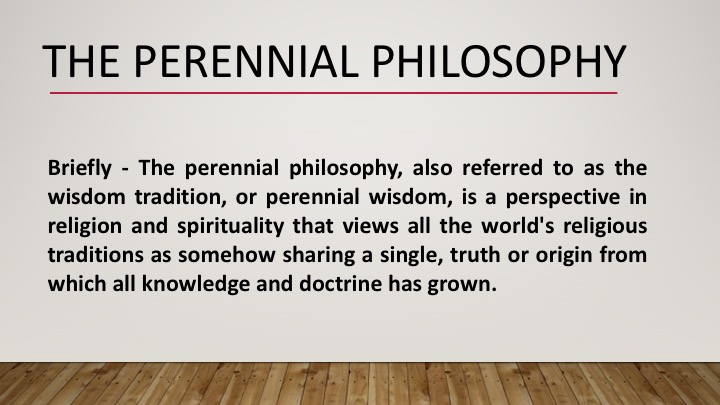
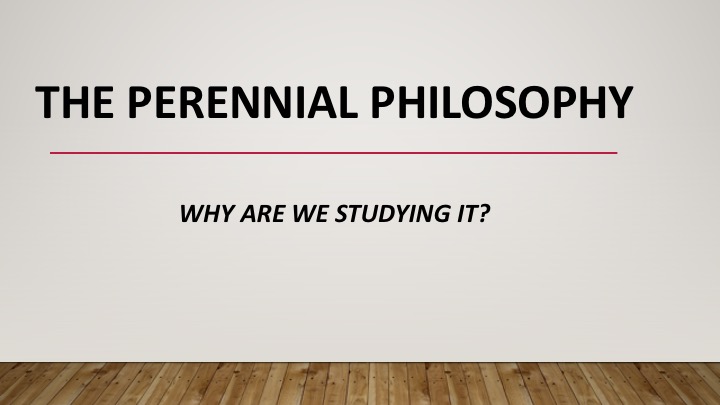
The Perennial Philosophy
Why Are We Studying it?
Now - before we leap with both feet into defining exactly what the Perennial Philosophy is, we need to give some perspective to the question “Why should we be interested in this?
And here I would like to suggest that understanding this Perennial Philosophy is related to another subject we discussed in June when I presented a one-week class on US Religious Demographics.
So I have lifted the content of two slides from that presentation that summarized a growing concern within Mainline Protestant churches relating to declining affiliation over the last two decades. And, of course our church is a mainline Protestant church.
And I am going to focus on a particular demographic that was noteworthy in those demographic studies.
So let’s look at previously presented information, in the next two slides.
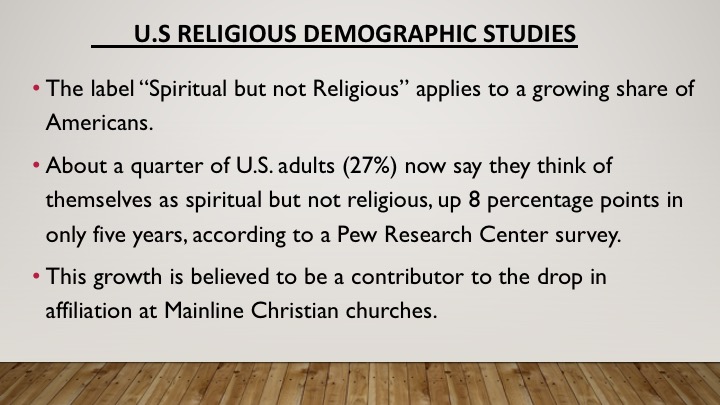
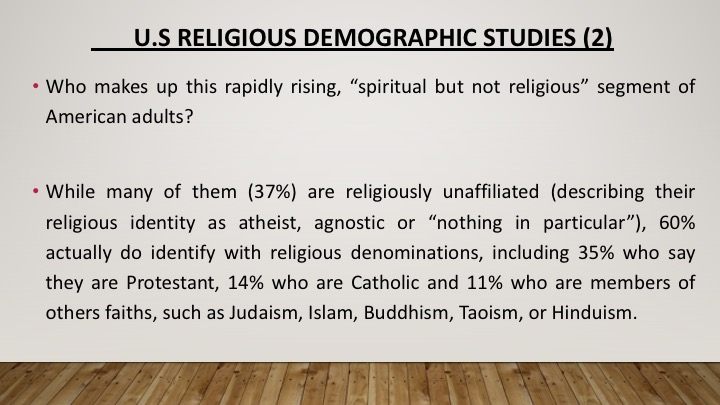
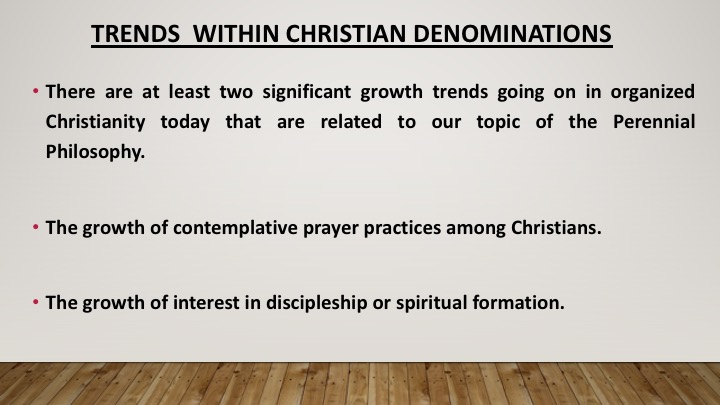
Let's briefly talk about each of these.
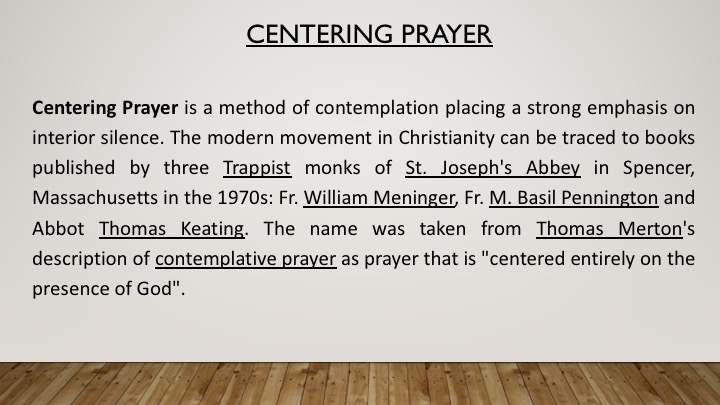
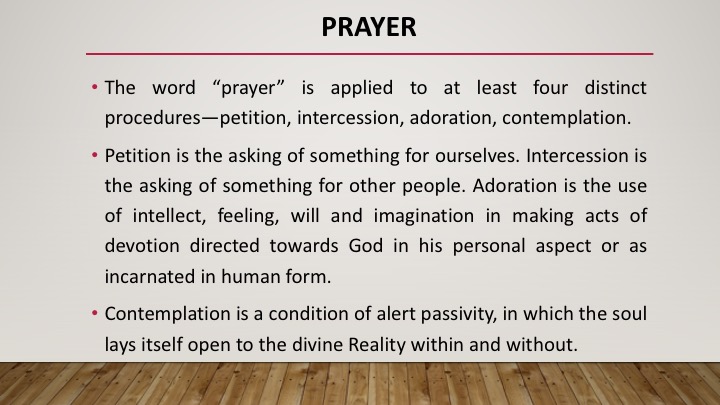
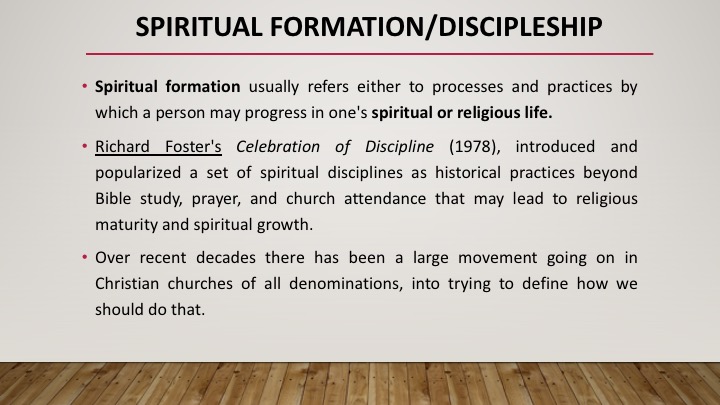
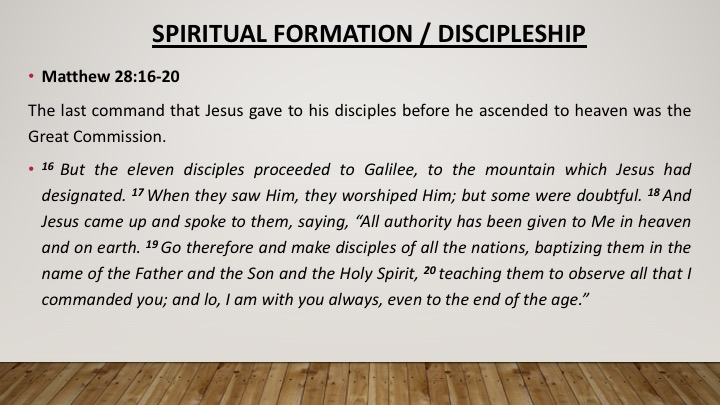
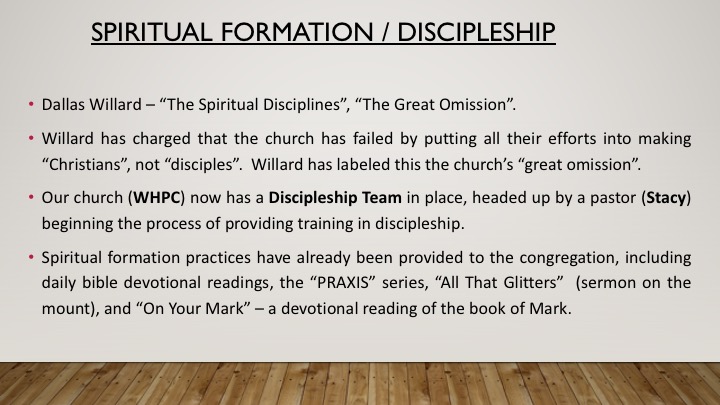
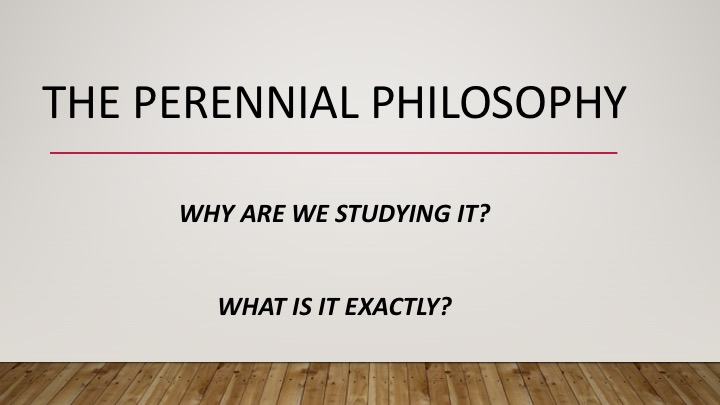
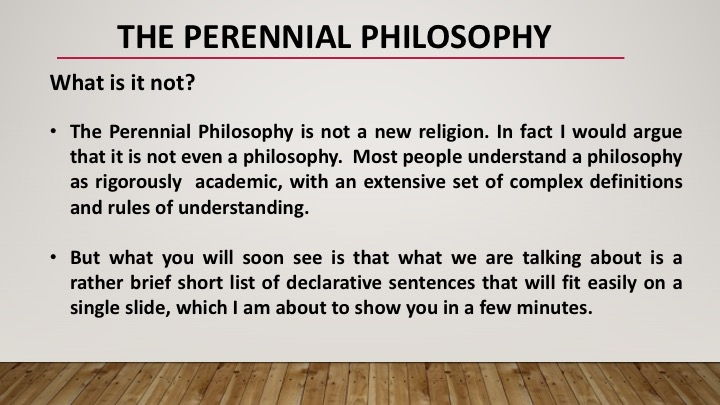
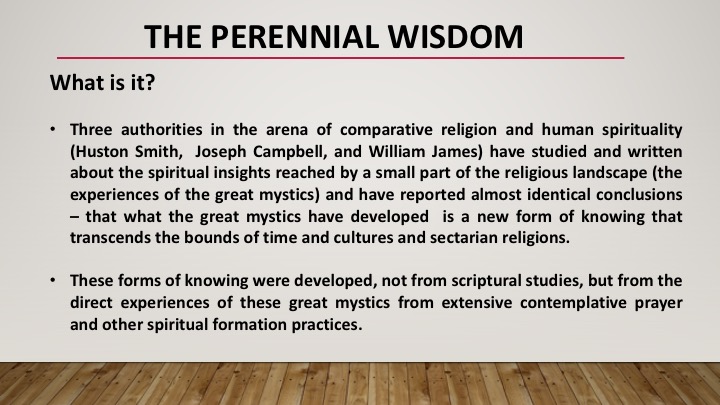
And where did all of this come from?
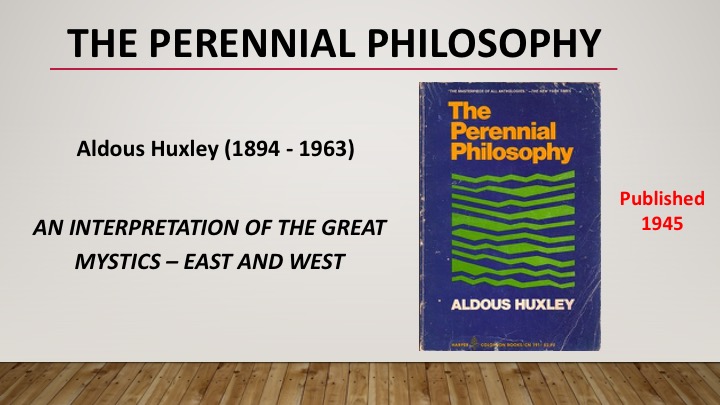
The Perennial Philosophy
Aldous Huxley (1894 - 1963)
Subtitle: AN INTERPRETATION OF THE GREAT MYSTICS – EAST AND WEST
Huxley's book, which was widely acclaimed, brought new attention to the Perennial Philosophy. It was praised by the New York Times as "The Masterpiece of All Anthologies". It has since been reprinted several times and is still selling today.
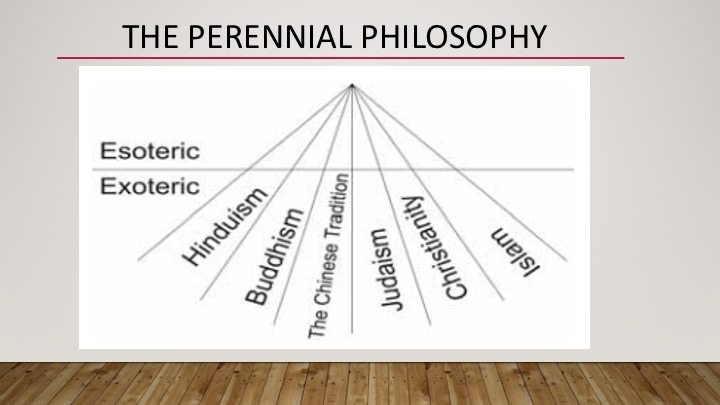
A Commonly Presented Image View of the Perennial Philosophy
One way the Perennial Philosophy is commonly illustrated is shown here. Major world religions are broken up into their exoteric aspects and esoteric aspects. The exoteric referring to their organized and visible presence of worship, ritual, theology, scripture, buildings, etc. And the esoteric to the more mystical side including the adherents that devote major time to contemplation and study. ie, the mystics of each religion.
This rendering is obviously oversimplified in that each of the exoteric world religions actually includes literally thousands of separate denominations, that often do not get along very well.
But the concept illustrated here is that when you trace back all of these exoteric religions to their mystical wings the experiences and interpretations of the esoteric mystics are in remarkable agreement regarding the nature of the Divine, the nature of humankind and its psychology, and the philosophy of ultimate reality.
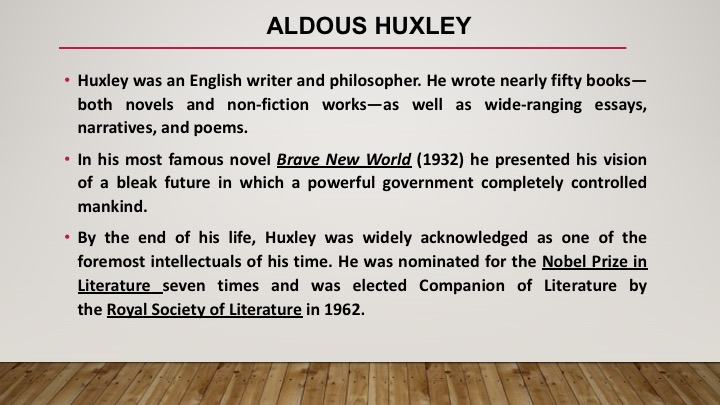
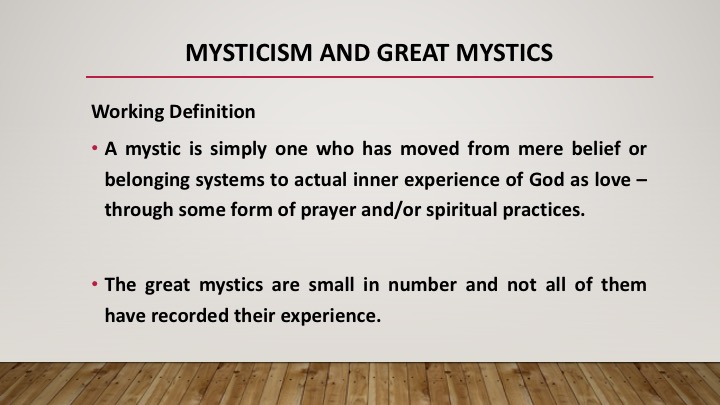
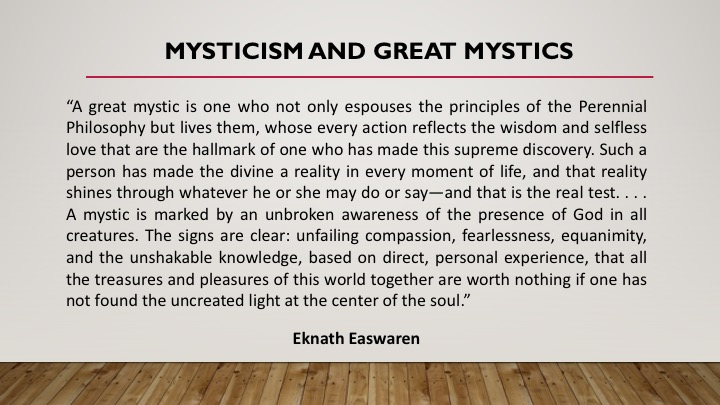
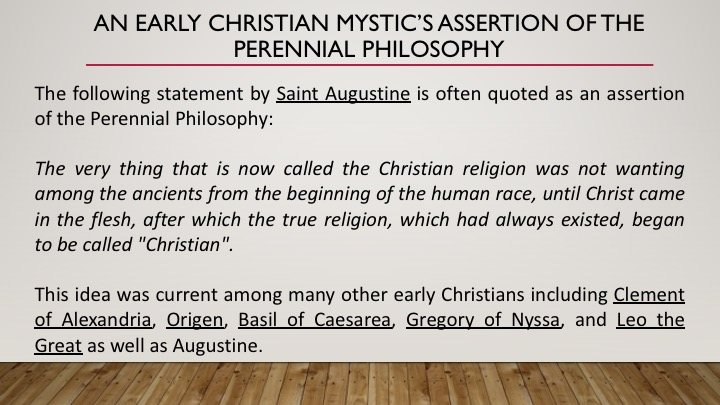
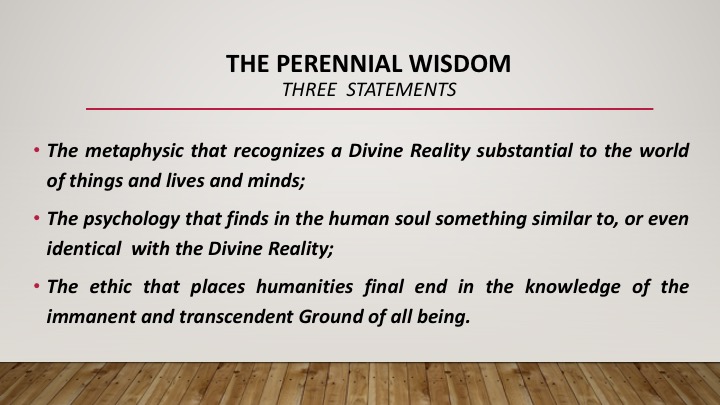
The
Perennial Wisdom
This is Huxley's definition of what all of the great mystics agree on. And in the rest of the book he comments on all of these and provides constant quotations from the great mystics of all the world religions to "prove" it. Huxley never intimates that this means all of these religions are the same. Far from it. He acknowledges that in their "exoteric" forms (organized religions) they will never come together.
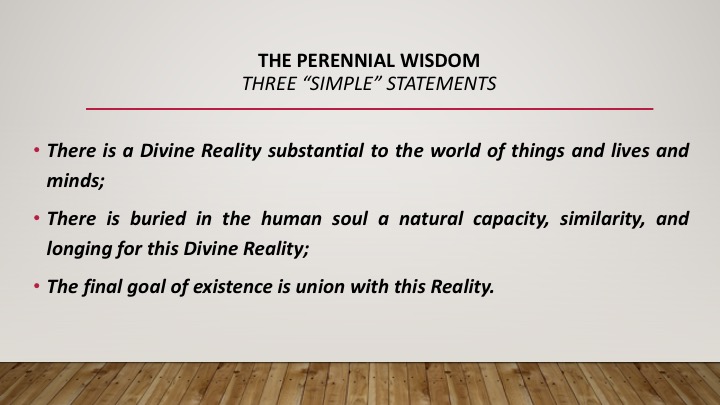
The Perennial Philosophy
Several writers have simplified Huxley's Three “Simple” statements as shown:
There is a Divine Reality substantial to the world of things and lives and minds;
There is in the soul a natural capacity, similarity, and longing for this Divine Reality;
The final goal of existence is union with this Divine Reality.
Now – I want you to understand that this view of the Perennial Wisdom did not originate with Huxley. Huxley did his homework but there was another summary of the Perennial Wisdom similar to this that was written 6 centuries before Huxley.
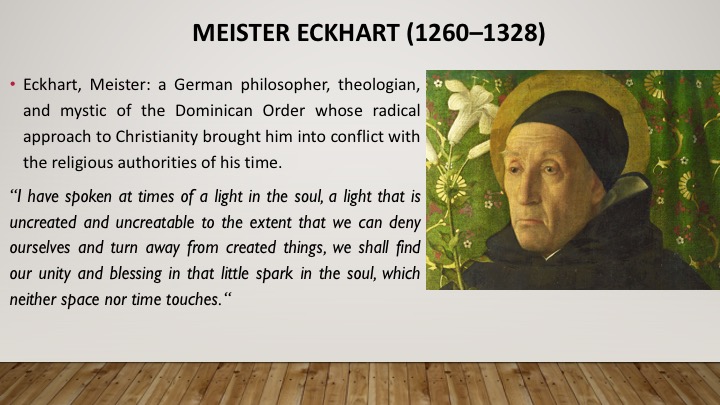
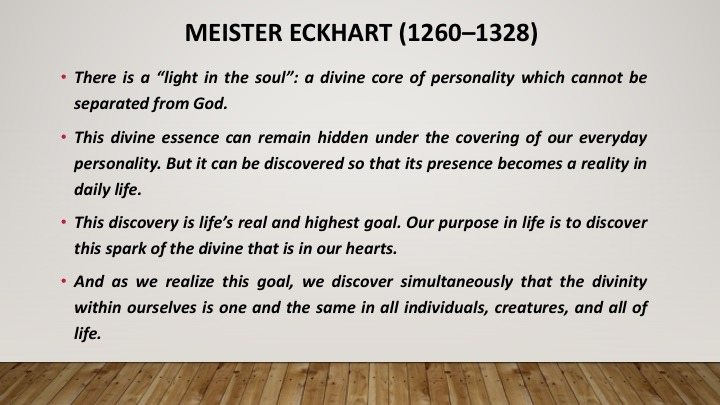
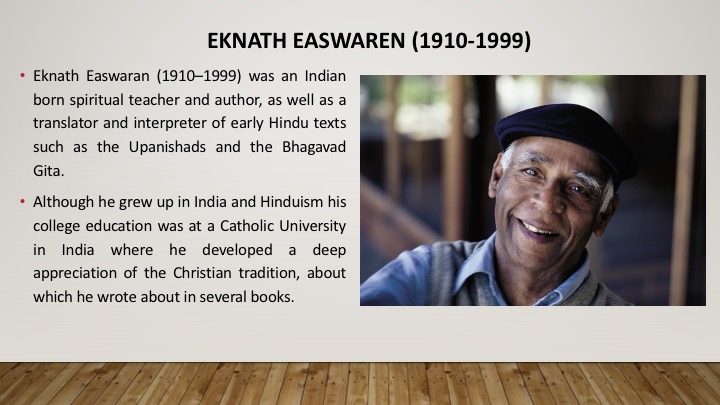
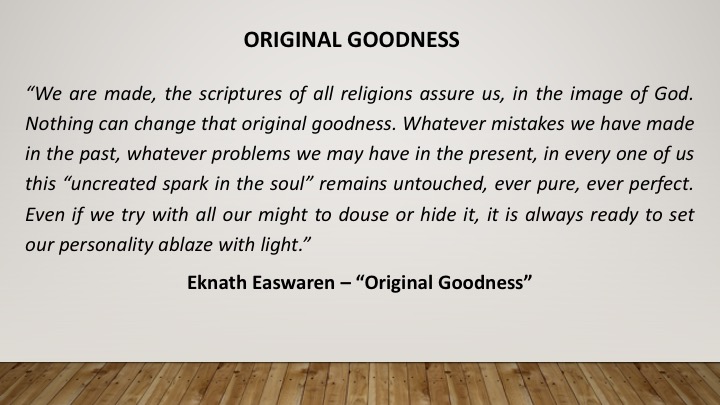
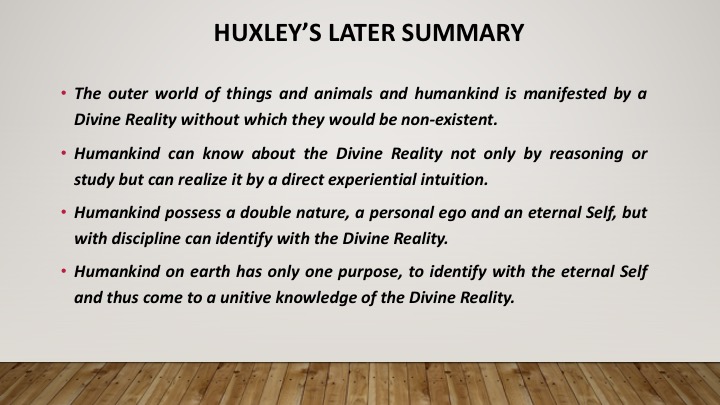
Huxley’s LATER Summary
After thinking about this for a few years Huxley reformulated his three statements into a somewhat clear formulation as shown in this slide.
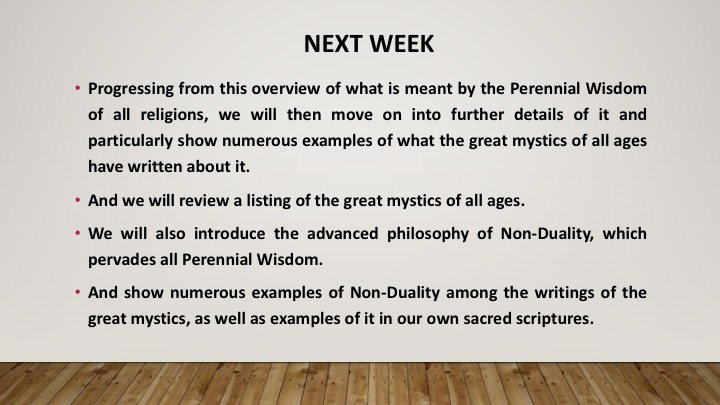
Perennial Philosophy Class 1
Links
< Home Page> < Perennial Philosophy Menu > < Top of Page >
The Perennial Philosophy. - the Text
Briefly - The perennial philosophy, also referred to as the wisdom tradition, or perennial wisdom, is a perspective in spirituality that views all the world's religious traditions somehow share a single, truth or origin from which all knowledge and doctrine has grown. This is quite an audacious claim, but after we examine it I think you may agree.
U.S Religious Demographic Studies
The label “Spiritual but not Religious” applies to a growing share of Americans.
About a quarter of U.S. adults (27%) now say they think of themselves as spiritual but not religious, up 8 percentage points in only five years, according to a Pew Research Center survey.
This growth is believed to be a contributor to the drop in affiliation at Mainline Christian churches.
U.S Religious Demographic Studies
The label “Spiritual but not Religious” applies to a growing share of Americans.
About a quarter of U.S. adults (27%) now say they think of themselves as spiritual but not religious, up 8 percentage points in only five years, according to a Pew Research Center survey.
This growth is believed to be a contributor to the drop in affiliation at Mainline Christian churches.
U.S Religious Demographic Studies (2)
Who makes up this rapidly rising, “spiritual but not religious” segment of American adults?
While many of them (37%) are religiously unaffiliated (describing their religious identity as atheist, agnostic or “nothing in particular”), 60% actually do identify with religious denominations, including 35% who say they are Protestant, 14% who are Catholic and 11% who are members of others faiths, such as Judaism, Islam, Buddhism, Taoism, or Hinduism.
TRENDS WITHIN CHRISTIAN DENOMINATIONS
There are at least two significant growth trends going on in organized Christianity today that are related to our topic of the Perennial Philosophy.
The growth of contemplative prayer practices among Christians.
The growth of interest in discipleship or spiritual formation.
Let's briefly talk about each of these.
Centering Prayer is a method of contemplation placing a strong emphasis on interior silence. The modern movement in Christianity can be traced to books published by three Trappist monks of St. Joseph's Abbey in Spencer, Massachusetts in the 1970s: Fr. William Meninger, Fr. M. Basil Pennington and Abbot Thomas Keating. The name was taken from Thomas Merton's description of contemplative prayer as prayer that is "centered entirely on the presence of God".
PRAYER
The word “prayer” is applied to at least four distinct procedures—petition, intercession, adoration, contemplation.
Petition is the asking of something for ourselves. Intercession is the asking of something for other people. Adoration is the use of intellect, feeling, will and imagination in making acts of devotion directed towards God in his personal aspect or as incarnated in human form.
Contemplation is a condition of alert passivity, in which the soul lays itself open to the divine Reality within and without.
Spiritual Formation/Discipleship
Spiritual formation usually refers either to processes and practices by which a person may progress in one's spiritual or religious life.
Richard Foster's Celebration of Discipline (1978), introduced and popularized a set of spiritual disciplines as historical practices beyond Bible study, prayer, and church attendance that may lead to religious maturity and spiritual growth.
Over recent decades there has been a large movement going on in Christian churches of all denominations, into trying to define how we should do that.
Spiritual Formation / Discipleship
Matthew 28:16-20
The last command that Jesus gave to his disciples before he ascended to heaven was the Great Commission.
"16 But the eleven disciples proceeded to Galilee, to the mountain which Jesus had designated. 17 When they saw Him, they worshiped Him; but some were doubtful. 18 And Jesus came up and spoke to them, saying, “All authority has been given to Me in heaven and on earth. 19 Go therefore and make disciples of all the nations, baptizing them in the name of the Father and the Son and the Holy Spirit, 20 teaching them to observe all that I commanded you; and lo, I am with you always, even to the end of the age.”
Now – you may or may not be aware that this particular command of Jesus has become quite controversial in some circles. It has been widely interpreted by Christians over the years as the command to be very active in mission work, so as to create more Christians. And you could argue that the church has responded to that – especially if you review the tremendous growth of Christianity globally, particularly in the global south.
But there has been a push-back on this interpretation of the Great Commission.
Spiritual Formation / Discipleship
Dallas Willard, a former Baptist minister and now professor of Philosophy has written much on discipleship and spiritual formation – “The Spiritual Disciplines”, “The Great Omission”.
Willard has charged that the church has failed by putting all their efforts into making “Christians”, but not “disciples”. Willard has labeled this the church’s “great omission”.
Over recent decades there has been a large movement going on in Christian churches of all denominations, into trying to define how we should do that.
Our church (WHPC) now has a Discipleship Team in place, headed up by a pastor (Stacy) beginning the process of providing training in discipleship.
Spiritual formation practices have already been provided to the congregation, including daily bible devotional readings, the “PRAXIS” series, “All That Glitters” (sermon on the mount), and “On Your Mark” – a devotional reading of the book of Mark. And more to come.
THE PERENNIAL PHILOSOPHY
WHY ARE WE STUDYING IT?
WHAT IS IT EXACTLY?
So, we have addressed some of the reasons this is a good area to study. But it is getting time to try to define exactly what is this Perennial Philosophy?
The Perennial Philosophy
What is it not?
The Perennial Philosophy is not a new religion. There will never be a Church of the Perennial Philosophy down the street from us. In fact I would argue that it is not even a philosophy. Most people understand a philosophy as rigorously academic, with an extensive set of complex definitions and rules of understanding.
But what you will soon see is that what we are talking about is a rather brief short list of declarative sentences that will fit easily on a single slide, which I am about to show you in a few minutes.
The Perennial Philosophy
What is it?
Three authorities in the arena of comparative religion and human spirituality (Huston Smith, Joseph Campbell, and William James) have studied and written about the spiritual insights reached by a small part of the religious landscape (the experiences of the great mystics) and have reported almost identical conclusions – that what the great mystics have developed is a new form of knowing that transcends the bounds of time and cultures and sectarian religions.
These forms of knowing were developed, not from scriptural studies, but from the direct experiences of these great mystics from extensive contemplative prayer and other spiritual formation practices.
And where did all of this come from?
The Perennial Philosophy
Aldous Huxley (1894 - 1963)
Subtitle: AN INTERPRETATION OF THE GREAT MYSTICS – EAST AND WEST
Huxley's book, which was widely acclaimed, brought new attention to the Perennial Philosophy. It was praised by the New York Times as "The Masterpiece of All Anthologies". It has since been reprinted several times and is still selling today.
Aldous Huxley
Huxley was an English writer and philosopher. He wrote nearly fifty books—both novels and non-fiction works—as well as wide-ranging essays, narratives, and poems.
In his most famous novel Brave New World (1932) he presented his vision of a bleak future in which a powerful government completely controlled mankind.
By the end of his life, Huxley was widely acknowledged as one of the foremost intellectuals of his time. He was nominated for the Nobel Prize in Literature seven times and was elected Companion of Literature by the Royal Society of Literature in 1962.
Mysticism and Great Mystics
Working Definition
A mystic is simply one who has moved from mere belief or belonging systems to actual inner experience of God as love – through some form of prayer and spiritual formation practices.
The great mystics are small in number and not all of them have recorded their experience.
Mysticism and Great Mystics - Eknath Easwaren
“A great mystic is one who not only espouses the principles of the Perennial Philosophy but lives them, whose every action reflects the wisdom and selfless love that are the hallmark of one who has made this supreme discovery. Such a person has made the divine a reality in every moment of life, and that reality shines through whatever he or she may do or say—and that is the real test. . . . A mystic is marked by an unbroken awareness of the presence of God in all creatures. The signs are clear: unfailing compassion, fearlessness, equanimity, and the unshakable knowledge, based on direct, personal experience, that all the treasures and pleasures of this world together are worth nothing if one has not found the uncreated light at the center of the soul.”
An Early Christian Mystic’s Assertion of the Perennial Philosophy
The following statement by Saint Augustine is often quoted as an assertion of the Perennial Philosophy:
The very thing that is now called the Christian religion was not wanting among the ancients from the beginning of the human race, until Christ came in the flesh, after which the true religion, which had always existed, began to be called "Christian".
This idea was current among many other early Christians including Clement of Alexandria, Origen, Basil of Caesarea, Gregory of Nyssa, and Leo the Great as well as Augustine.
The Perennial Philosophy
Three Statements of Huxley in the opening
chapter:
The metaphysic that recognizes a Divine Reality substantial to the world of things and lives and minds;
The psychology that finds in the human soul something similar to, or even identical with divine Reality;
The ethic that places man’s final end in the knowledge of the immanent and transcendent Ground of all being.
This is Huxley's definition of what all of the great mystics agree on. And in the rest of the book he comments on all of these and provides constant quotations from the great mystics of all the world religions to "prove" it. Huxley never intimates that this means all of these religions are the same. Far from it. He acknowledges that in their "exoteric" forms (organized religions) they will never come together.
Eckhart, Meister: a German philosopher, theologian, and mystic of the Dominican Order whose radical approach to Christianity brought him into conflict with the religious authorities of his time.
“I have spoken at times of a light in the soul, a light that is uncreated and uncreatable to the extent that we can deny ourselves and turn away from created things, we shall find our unity and blessing in that little spark in the soul, which neither space nor time touches. “
MEISTER ECKHART'S PERENNIAL PHILOSOPHY
•There is a “light in the soul”: a divine core of personality which cannot be separated from God.
•This divine essence can remain hidden under the covering of our everyday personality. But it can be discovered so that its presence becomes a reality in daily life.
•This discovery is life’s real and highest goal. Our purpose in life is to discover this spark of the divine that is in our hearts.
•And as we realize this goal, we discover simultaneously that the divinity within ourselves is one and the same in all individuals, creatures, and all of life.
Eknath Easwaren (1910-1999)
Eknath Easwaran was an Indian born spiritual teacher and author, as well as a translator and interpreter of early Hindu texts such as the Upanishads and the Bhagavad Gita.
Although he grew up in India and Hinduism his college education was at a Catholic University in India where he developed a deep appreciation of the Christian tradition, about which he wrote in several books.
Original Goodness
Easwaren wrote in his book "Original Goodness" - a commentary on the Beatitudes of Jesus, that:
“We are made, the scriptures of all religions assure us, in the image of God. Nothing can change that original goodness. Whatever mistakes we have made in the past, whatever problems we may have in the present, in every one of us this “uncreated spark in the soul” remains untouched, ever pure, ever perfect. Even if we try with all our might to douse or hide it, it is always ready to set our personality ablaze with light.”
Note that Easwaren's "uncreated spark in the soul" was borrowed from Meister Eckhart, the Christian mystic that Easwaren greatly admired (and copied).
Eknath Easwaren – “Original Goodness”
Huxley’s LATER Summary
After thinking about this for a few years Huxley reformulated his three statements into a somewhat clear formulation:
The outer world of things and animals and humankind is manifested by a Divine Reality without which they would be non-existent.
Humankind can know about the Divine Reality not only by reasoning or study but can realize it by a direct experiential intuition.
Humankind possess a double nature, a personal ego and an eternal Self, but with discipline can identify with the Divine Reality.
Humankind on earth has only one purpose, to identify with the eternal Self and thus come to a unitive knowledge of the Divine Reality.
Next Week
Progressing from this overview of what is meant by the Perennial Wisdom of all religions, we will then move on into further details of it and particularly show numerous examples of what the great mystics of all ages have written about it.
And we will review a listing of the great mystics of all ages.
We will also introduce the advanced philosophy of Non-Duality, which pervades all Perennial Wisdom.
And show numerous examples of Non-Duality among the writings of the great mystics, as well as examples of it in our own sacred scriptures.